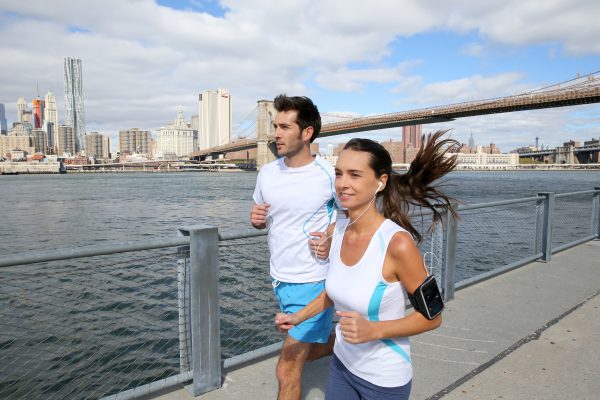
A steady rain was falling when I crossed the finish line of the fourteenth annual New York City Marathon on the afternoon of October 23, 1983. My time was four hours, seventeen minutes, and thirty-five seconds.
“Why,” you may ask, “was a man of your age [I was fifty-four at the time and in my fifth year of sobriety] want to run 26.2 miles on a cold, rainy day in New York when you could be having eggs Benedict at Longchamps and going to the theater?”
The quick answer was that the New York City Marathon is special. This is Stallone’s “Rocky” territory—a day when the average Joes like me—not just the Kenyans—can finish the grueling race and become heroes if they’re willing to train for it.
For a while, those of us who ran in it were the Yankees in the World Series, the Giants in the Super Bowl, and the Rangers in the Stanley Cup playoffs. There are just not any fans like New York fans, and we were pumped.
But there was another reason I ran. Part of my program of recovery from the beginning had been to get out of myself, be with other people, and become more physically as well as spiritually fit. I had lettered in track at college, and running seemed to be a good way to at least make a beginning. I continued running–5 k’s and 10 k’s–and, now that I could see the ball, I took up tennis again-a sport my three sons excelled in. My wife and I also took up doubles again and our social life improved.
As for the marathons, to some, my training schedule looked a little obsessive. Hadn’t I just traded one addiction for another? Perhaps, but is that necessarily a bad thing? In my opinion, if it had meant neglecting my responsibilities to my job and family, yes. Otherwise, no.
Let me describe in the next few paragraphs a little more of my 1983 New York City Marathon experience to give you a sense of how it feels.
We started down the slope of the Verazano Bridge on Staten Island, where the marathon began, and as came into Brooklyn, the sounds of the crowds cheering swelled. Wow! I felt as if I were entering an arena—just like Rocky.
The New York City Marathon is an event, and it confers upon participants’ momentary celebrity status. As we ran along Brooklyn’s Fourth Avenue, children darted out to slap palms with us in little high fives, older spectators offered us water and other beverages, and whole families erupted out of windows to cheer us on in a variety of dialects.
Our trip took us through New York’s five boroughs, beginning with Staten Island and then through Brooklyn, as I said, and on into Queens, the Bronx (which included Harlem), and then down through Central Park into Manhattan.
Passing the Plaza
Near the end of the run, as I emerged from Central Park and turned up Fifty-Ninth Street, I looked over at the Plaza, that monument to romance, and I remembered the days of wine and roses.
During the late 1950s and 1960s, I had worked for several advertising agencies in Manhattan—part of the time near the Plaza, where I became overly familiar with the two-martini lunch at the Oak Room and other fashionable watering holes.
I stumbled past my old friend, the Plaza, and on into the gray wet afternoon toward Columbus Circle, momentarily buoyed by the encounter. I could almost hear Mel Torme, above the screaming of my quads and lower back, singing “Autumn in New York.”
There is a camaraderie about a marathon, the kinship of a shared experience, which in the final six miles became almost surreal. As in John Cheever’s “Swimmer,” seasons seemed to change, runners seemed to age, and a penetrating wintry dampness overtook us as we struggled to keep it together physically and emotionally.
When I crossed the finish line in 4 hours and 17 minutes, I heard a race official say sincerely, if not exactly accurately, “Great race. Nice going. Good pace.”
On the way to the shelter offered by a fleet of parked, heated buses, I looked across at a young girl walking next to me. She was bundled up, as I was, against the cold in her aluminum foil “space blanket,” and she clutched a single red rose, her prize for finishing. We both smiled. We had been in there pitching together for hours during the good times and the bad, and we may not have known one another, but we were close.
Once in the bus, I sat there in my Perrier shorts and New York City Marathon T-shirt, a pewter medal around my neck, exchanging knowing grins with my fellow runners. I felt great. Sure, my muscles were beginning to seize up, but soon I would get off the bus (backwards, because of those quads, as it turned out) and meet members of my family near the Tavern on the Green.
We would have that hot cup of tea I had been dreaming of. And maybe eggs Benedict.
P.S. After the New York marathon, I limited my running to 10k’s and 5k’s, played some tennis and began regular workouts at what is now the Little Rock Athletic Club. Today I go to the Athletic Club five days a week, where I ride the stationary bikes, stretch and do the weight machines and hit the steam room. I’m 88. So far, so good.




Leave a Reply